In our opinion, one of the first things all WordPress users should learn is how to deactivate WordPress plugins. We’re not just talking about how to do it from the admin area, but also how to deactivate plugins when you’re locked out of your site.
The reason is that knowing how to deactivate (and when needed, uninstall) plugins properly is important for troubleshooting WordPress errors. Plus, when not managed properly, too many plugins can slow down your website.
In this comprehensive guide, we’ll show you different ways to easily deactivate WordPress plugins.
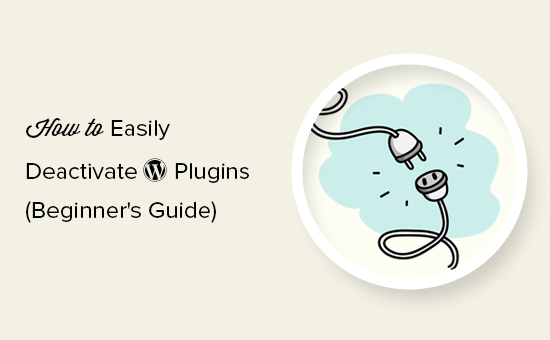
Here is an overview of what you will learn in this article. You can use the quick links to jump to the different sections:
- Method 1: Deactivate a Single Plugin in WordPress Admin
- Method 2: Bulk-Deactivate Plugins in WordPress Admin
- Method 3: Disable All Plugins in WordPress via FTP or File Manager
- Method 4: Disable All WordPress Plugins via phpMyAdmin
- What Is the Difference Between Deactivating vs Uninstalling a WordPress Plugin?
- How to Properly Uninstall a WordPress Plugin
- Should You Keep Deactivated WordPress Plugins Installed on Your Site?
- How to Disable WordPress Plugin Updates
- How to Deactivate WordPress Plugins for Your Website's Mobile Version
Method 1: Deactivate a Single Plugin in WordPress Admin
Let’s start with deactivating a single plugin.
If you want to temporarily disable a WordPress plugin, then you need to simply visit the Plugins » Installed Plugins page in your WordPress admin area.
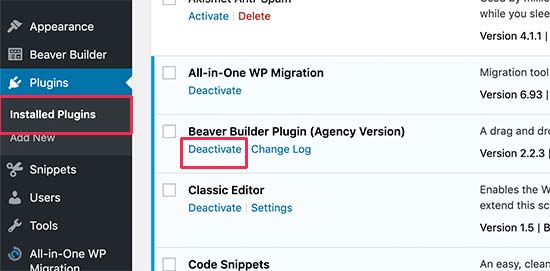
From here, you need to locate the WordPress plugin that you want to deactivate. Next, take your mouse to the plugin’s row, and it will show you a link to ‘Deactivate’ that plugin.
Clicking on the link will deactivate the WordPress plugin right away.
Once you deactivate the plugin, it remains installed on your website or blog, but WordPress will stop loading it.
If you want to start using the plugin again, then you will just need to click on the ‘Activate’ link below it.
Method 2: Bulk-Deactivate Plugins in WordPress Admin
Sometimes, you may need to deactivate all WordPress plugins on your website to troubleshoot issues. Instead of deactivating one plugin at a time, WordPress makes it easy to deactivate multiple or all WordPress plugins quickly.
Simply visit the Plugins » Installed Plugins page and check the box next to the plugins you want to deactivate. If you want to deactivate all WordPress plugins, then simply check the box at the top to select all plugins.
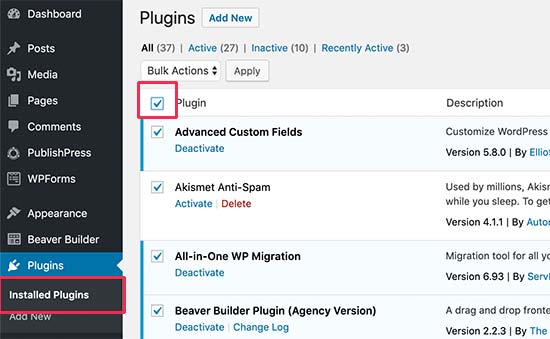
Next, you need to select ‘Deactivate’ from the ‘Bulk Actions’ drop-down menu.
After that, click the ‘Apply’ button.

WordPress will now deactivate all selected WordPress plugins.
Method 3: Disable All Plugins in WordPress via FTP or File Manager
If you have been locked out of your WordPress admin area and you cannot recover your password, then you will not be able to deactivate WordPress plugins from your dashboard.
Of course, you can try using WordPress recovery mode first. But if that doesn’t work either, you will need to disable plugins using other methods.
The easiest option is to deactivate WordPress plugins via file transfer protocol (FTP) or the File Manager app in your WordPress hosting dashboard.
Basically, WordPress looks for your installed plugins in the /wp-content/plugins/ folder. If it cannot find the plugin’s folder, then WordPress will automatically deactivate all plugins.
Instead of deleting the plugin’s folder, we will just rename it.
First, you will need to connect to your WordPress site using an FTP client like FileZilla. Once connected, you must navigate to the wp-content folder inside your WordPress root directory.

From here, you need to right-click on the plugins folder and then select ‘Rename’.
This will bring up a popup where you need to enter a new name for your plugin’s folder, such as ‘plugins-deactivated’.

Your FTP client will now rename the plugin’s folder. You can now try to log in to your WordPress admin area and visit the Plugins page.
Here, you will see notifications about deactivated WordPress plugins.
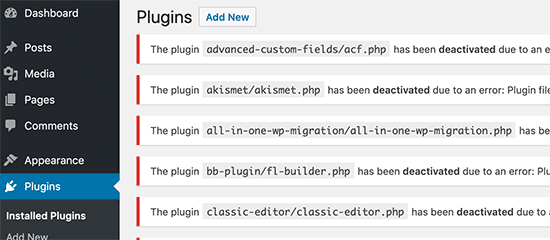
For more details, please see our beginner’s guide on how to disable WordPress plugins without admin access.
Method 4: Disable All WordPress Plugins via phpMyAdmin
The FTP method is definitely easier, in our opinion. However, you can also deactivate all plugins using phpMyAdmin. This is a database management tool that you can access via your hosting account dashboard.
Note: For this method, please make a complete database backup first to prevent errors in case anything goes wrong.
First, you will need to log in to your web hosting account dashboard. Next, locate and click on the phpMyAdmin icon.
If you use Bluehost, then you need to go to the ‘Websites’ tab and click ‘Settings’ on your website.
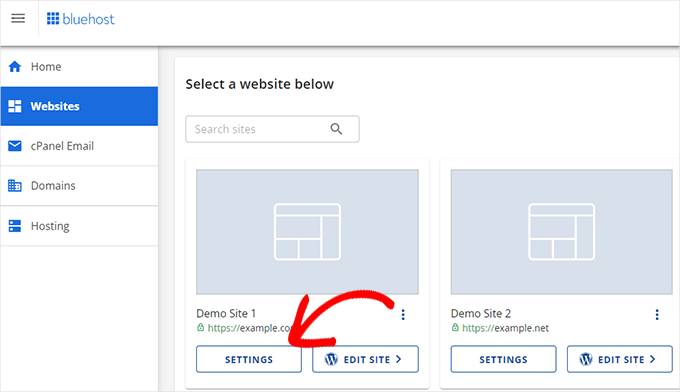
Then, you can scroll all the way down the page.
The ‘phpMyAdmin’ button should be inside the ‘Quick Links’ section.
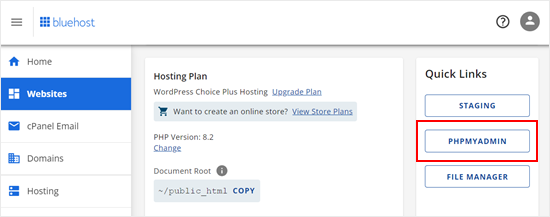
Click on it, and this will bring you to the phpMyAdmin interface.
First, you will need to select your WordPress database from the left menu.
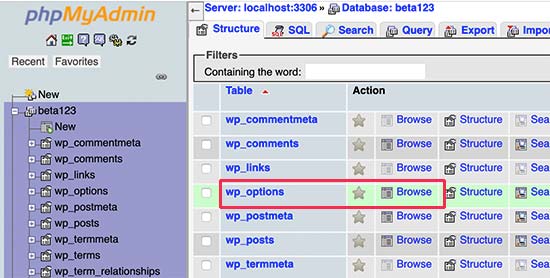
phpMyAdmin will now load your database tables in the right panel. You need to click on the ‘Browse’ button next to the ‘wp_options’ table. Note that your WordPress table name may differ depending on your WordPress database table prefix.
Now, phpMyAdmin will load data inside the wp_options table. You need to scroll down to the ‘active_plugins’ row and click on the ‘Edit’ button next to it.
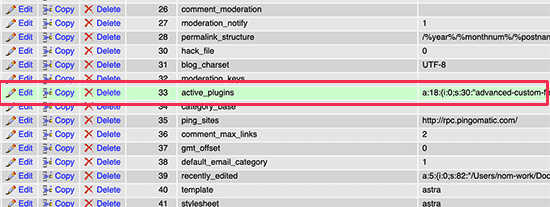
phpMyAdmin will open the row for editing. You need to delete the data inside the ‘option_value’ field.
After that, simply click on the ‘Go’ button at the bottom to save your changes.
You can now visit your WordPress website, and WordPress will see that all plugins have been deactivated.
What Is the Difference Between Deactivating vs Uninstalling a WordPress Plugin?
The difference between deactivating vs. uninstalling a WordPress plugin is quite simple.
When you deactivate a WordPress plugin, it is simply turned off. However, it is still installed on your website, so you can activate it again if you need to.
On the other hand, uninstalling a plugin completely deletes it from your website. You will not be able to see the plugin on the Plugins » Installed Plugins page.
If you want to use that same plugin again, then you will have to reinstall it. Plus, you have to set the plugin up from scratch, as your previous configurations will also be deleted.
These principles also apply to deactivating and uninstalling WordPress themes.
How to Properly Uninstall a WordPress Plugin
WordPress makes it super easy to uninstall plugins from the admin area. Simply log in to your WordPress dashboard and go to the Plugins page.
You will see the list of currently installed plugins on your site. Your active plugins will be highlighted with a blue background.
If you want to uninstall an active plugin, then first, you will need to deactivate it. After that, click on the ‘Delete’ link below it.
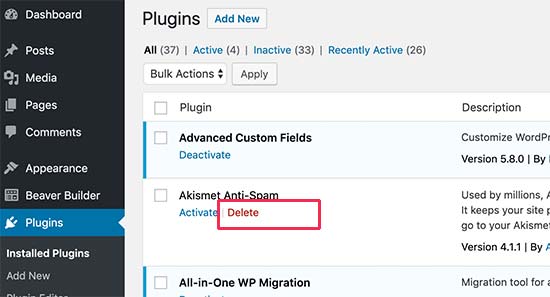
WordPress will now ask you to confirm that you want to delete the plugin.
Simply click ‘OK’.
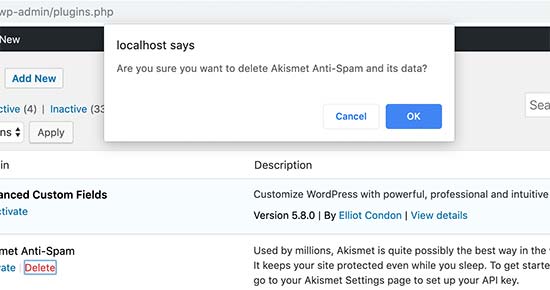
WordPress will now safely remove the plugin from your web server and uninstall it from your website.
However, some WordPress plugins leave traces of data and files even when they are uninstalled. These items don’t have any significant impact on your WordPress site. But if you want to remove them, then this is how you do it.
Removing Unused Shortcodes
Many WordPress plugins use shortcodes to add content to your posts or pages. Once you deactivate or uninstall a plugin, those shortcodes will become visible in your posts, and they look quite ugly.
[pluginshortcode]
You can easily disable shortcodes by adding the following code to your theme’s functions.php file or by using WPCode:
add_shortcode( 'pluginshortcode', '__return_false' );
For more details, please see our guide on how to easily add custom code in WordPress.
This code basically adds the shortcode back and makes it display nothing. Don’t forget to replace pluginshortcode with the shortcode tag used by the plugin you want to remove.
It is important to note that you will need to remove this code if you ever decide to use that plugin again.
Cleaning Up Plugin Traces From the WordPress Database
Some WordPress plugins create their own tables in the WordPress database. If these tables have too much data in them, then they will increase your WordPress backup size.
To clean these up, you need to launch phpMyAdmin from your WordPress hosting dashboard.
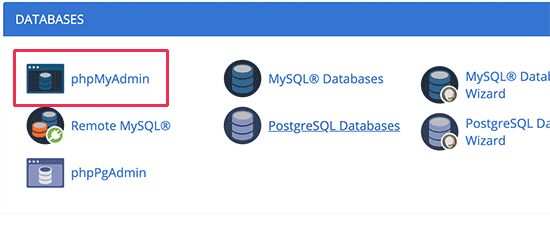
You need to click on your database and then select the tables you want to delete. Usually, databases created by plugins will have a database prefix that contains the plugin name or an abbreviation of the plugin name.
Below the tables list, you will see a drop-down labeled ‘With selected’. Simply click on the drop-down, and then select ‘Drop’.
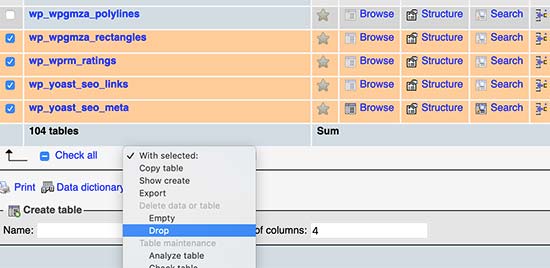
Next, you will see a warning that you are about to delete these tables. You need to click on ‘Yes’ to confirm the action.
Please note that this is irreversible. Once it is deleted, you will not be able to restore these tables unless you have a database backup.
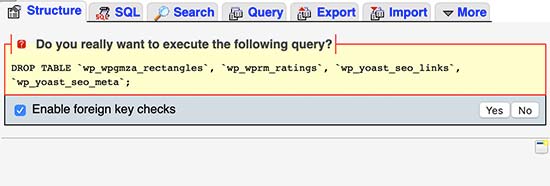
phpMyAdmin will now delete the database tables from your unused plugins.
For more information, check out our WordPress database maintenance guide.
Cleaning Up Unused WordPress Plugin Files
Often, WordPress plugins create files and folders on your hosting server. These files are usually harmless, but they can increase your WordPress backup size.
To delete them, you need to connect to your WordPress site using an FTP client. Once connected, you need to go to the wp-content folder. You will find files and folders created by plugins inside the ‘uploads’ and ‘plugins’ folders.
Make sure that the files you are deleting are created by the plugin that you have uninstalled. After that, simply delete them from your web server.

Should You Keep Deactivated WordPress Plugins Installed on Your Site?
If you are not going to use those plugins, then you should not keep inactive or deactivated WordPress plugins installed on your website.
Inactive plugins don’t necessarily slow down your website. However, plugins may contain executable files and can be used by hackers to hide malware or a backdoor.
Apart from security concerns, they can also increase your WordPress backup size, show up as false positives in security scans, and cause other issues.
This is why we always recommend users delete inactive plugins from their sites.
How to Disable WordPress Plugin Updates
There are situations where you might want to disable updates for specific plugins rather than completely deactivating them.
Perhaps you’re concerned a new update could cause compatibility issues with other plugins or your theme. Maybe you prefer to thoroughly test updates on a staging site before deploying them to your live website.
In rare cases, you might be using a reliable legacy plugin that’s no longer actively supported. Disabling updates ensures it keeps functioning as intended.
However, it’s important to weigh the risks before taking this route. Disabling plugin updates means your website won’t receive security patches that fix vulnerabilities exploited by hackers.
This can leave your site exposed to potential WordPress security breaches.
Additionally, updates often address bugs and improve plugin performance. By skipping updates, you miss out on these improvements and might experience bugs or slower website performance.
New updates can also introduce valuable features and functionalities, which you’ll miss out on if you disable them.
Ultimately, the decision to disable plugin updates is yours. But it should be a last resort and only considered in exceptional situations.
If you understand the risks and still want to continue, you can refer to our guide on how to disable plugin updates in WordPress to do it safely.
How to Deactivate WordPress Plugins for Your Website’s Mobile Version
These days, it’s important that your website’s mobile, tablet, and desktop versions are equally fast. That said, there may be cases when plugins can slow down the mobile version of your website.
In this case, you may want to consider deactivating plugins for mobile viewers. If you want to learn more about this, then check out our guide on how to disable specific plugins for mobile users.
We hope this article helped you learn how to properly deactivate WordPress plugins. You may also want to see our guide on why you can’t install WordPress plugins and our list of must-have WordPress plugins.
If you liked this article, then please subscribe to our YouTube Channel for WordPress video tutorials. You can also find us on Twitter and Facebook.





Samuel
I was working on a client’s website and I got the “403 forbidden error” which lock me out of the WordPress Dashboard and thus was unable to deactivate plugins in the normal way. This article safe the day for me. Thanks so much WpBeginner. Great job!
Jiří Vaněk
Could you recommend any plugin to check the database and delete old data after uninstalling plugins? Sometimes it happens that I get to some ready-made site where I don’t know the history. I don’t know what plugins have been installed there and what tables are no longer used. Is there some nifty program that can identify and delete such tables to reduce the size of the database?
WPBeginner Support
We do have a plugin we recommend in our guide below!
https://www.wpbeginner.com/plugins/how-to-clean-up-your-wordpress-database-for-improved-performance/
Admin
Jiří Vaněk
Thank you for answer. I happen to use Sweep, but only for revisions because I don’t yet fully understand the other items this plugin allows you to delete. I’ll try to focus more on that.
fakhir
excellent work very helpful for WordPress users.
WPBeginner Support
Glad you found our guide helpful!
Admin
farhan
what happen to the customize setting of plugin after deactivate, example if deactivate wprocket plugin the still available or not
WPBeginner Support
It would depend on the specific plugin and how they handle their settings for what customization settings would stay and what wouldn’t.
Admin